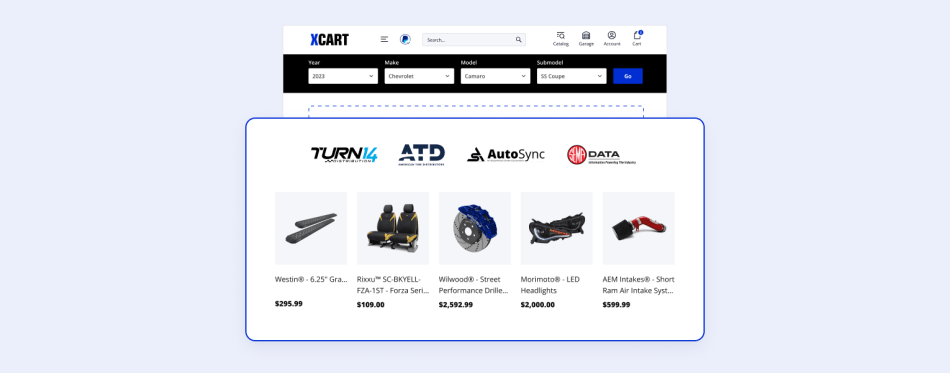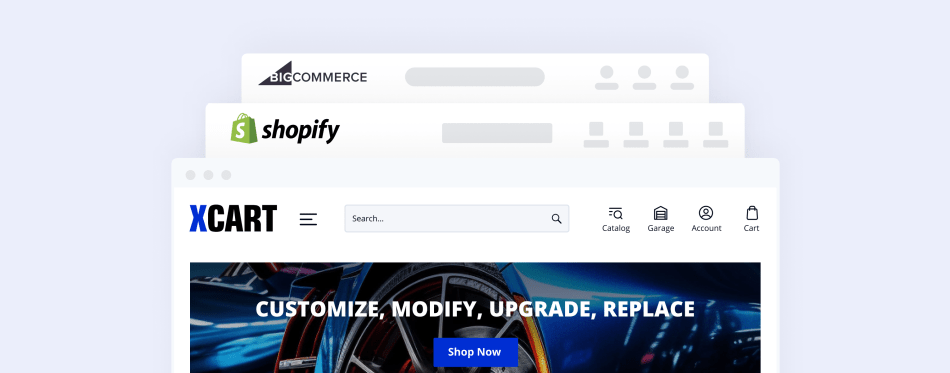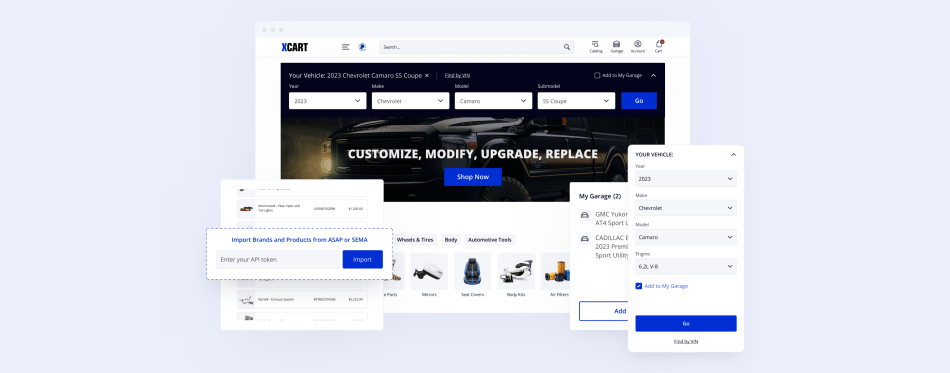A Step-by-Step Guide to Switching eCommerce Platforms for a Smooth and Low-Risk Migration
In the constantly evolving eCommerce environment, if you don’t pivot your business toward the emerging trends, you open up the opportunity for the competition to outpace you.
Having a flexible and easily scalable eCommerce platform is the best way to stay on top of new technologies. But, no matter how good your original shopping cart solution was when you first launched your new site, it may no longer answer your business goals. And this is where the time for a change comes.
However, the ongoing economic woes spell an uncertain future for eCommerce players facing the spectrum of fears that hold them back from migrating to a completely different solution. To help you mitigate some of the stressors and ease your replatforming concerns, we’ve put together the best practices and top eCommerce website migration tips to ensure your project goes smoothly.
In this blog post we uncover:
- The main reasons for switching eCommerce platforms.
- eCommerce migration checklist.
- What not to do during eCommerce migration.
- How migrating your online store to X-Cart will resolve most website issues.
Reasons to Set the Replatforming Project in Motion
For any eCommerce business, the reasons behind the decision to move to another platform are generally individual. Still, the most common factors are technical limitations, business-specific functionality gaps, poor website design, and elevated maintenance costs, to name a few. Reducing future expenses is also among the main reasons to migrate to a new shopping cart.
Replatforming is meant to improve your internal business processes, enrich functionality, make the website design more responsive and mobile-friendly, enhance the overall customer experience, and fill security gaps.
A few signals that indicate it’s time to move on and change your outdated eCommerce solution are:
- Each time you have spikes in website traffic, they cause downtimes.
- Your online store’s speed is slower during the high season when the traffic is higher than usual.
- Your eCommerce platform’s default functionality no longer meets your growing business needs.
- Your eCommerce platform lacks prebuilt business-specific integrations with third-party apps and offers few to no options for customization.
- The cost of ownership grows day by day.
- The competition is already ahead of you, offering a better user experience.
- Your web store is not mobile-responsive.
- Your website’s design looks outdated.
- Your platform provider doesn’t ensure adequate eCommerce website security.
- Poor website usability and navigation lead to low conversions and high bounce rates.
- You have issues with indexing, which is a sign that your eCommerce platform is not ready for SEO.
If you experience at least three of the problems above, it may be the right time to consider replatforming.
The eCommerce Replatforming Checklist
Today’s eCommerce websites have multiple internal integrations and store numerous databases, from product categories to customer lists to historical sales and tax reports, to name a few. Transferring such complex eCommerce systems in one fell swoop increases the chances of a mistake and puts the overall website’s performance at risk.
The more prudent option is not to bite more than you can chew and split the process into several stages to implement each one step at a time.
👉 Start with the list of things your eCommerce platform lacks
Try to think out of the box and assess the overall performance of your current platform to spot the issues you would like to resolve in the future and consider the processes that can be automated. You can also spy on your competitors to borrow some ideas from them.
👉 Gather feedback from every member of your team
Get feedback from your sales and customer support teams working tightly with the clients to have the best insight into what features your customers anticipate. At the same time, focus on the efficiency of your internal processes to reveal your business’s sore spots, including such things as security, scalability, and website’s responsiveness, to name a few.
👉 Put down the list of desirable features you are seeking in a new platform
Get a new angle on your business requirements and create a list of must-have features for your eCommerce website.
Just a couple of ideas for you:
- unlimited product catalog
- smart search functionality
- integrations with the top-notch marketing apps, payment gateways, and shipping software
- robust reporting tools to track sales and revenue
- intuitive interface and flexible checkout
- mobile-first web design
- high level of security
- enhanced SEO tools
- extended customization options
- functionality for selling globally
- opportunities for going omnichannel
- and more to help you scale your business and stay ahead of the pack
👉 Evaluate the budget for your replatforming project
The overall cost of eCommerce platform migration includes the price of the new software and the cost of expert assistance. However, given the complexity of eCommerce replatforming, business owners risk running out of the estimated amount of dollars they initially planned to invest. This is why you need a carefully elaborated plan that will help you control overspending.
👉 Work out a detailed eCommerce migration plan
Each replatforming project varies from business to business, however the common steps always involve:
- Orchestration phase. Map out the areas of your business that may be impacted during replatforming and optimize operations to minimize website performance disruptions.
- Content audits and backups. Backing up all the eCommerce store data is a good practice that will save you a lot of headaches in case of an error.
- Migrating website data. Assess whether you need any data migration services or an expert to transfer all your data.
- Website’s branding and redesign. Decide whether to hire a designer or pick one of the pre-built design templates the new eCommerce platform offers.
- Custom functionality. Consider all the custom features to have them developed from scratch or replace them with the existing add-ons or integrations on a new eCommerce platform.
- SEO migration planning. Conduct an SEO audit to thoroughly plan and transfer your search engine ranking, authority, and indexing signals. Carefully map all the redirects or let an SEO expert do it for you.
- Pre-launch training. Test it from the ground up to be 100% sure that your storefront and admin backend work perfectly. Try to predict the future buyer’s scenario and walk the customer’s path to purchase.
- Website launch. Communicate the changes to your customers by making an announcement. They are likely to spot the changes, so be aware and show them the benefits of working with a new platform.
- Post-launch testing and debugging. Have a team of migration experts who will spot and eliminate potential issues and ensure your new website meets your expectations.
👉 Choose an eCommerce platform
To pick an ideal eCommerce solution for your online store, consider your business logic and assess the capabilities of a new platform in the context of your business goals. When it comes to eCommerce platform type, they typically fall into three categories:
API-driven eCommerce platforms: The essence of the API-driven solutions is in their modular structure that allows for creating an interconnected digital ecosystem that can be scaled and adjusted to your ever-evolving business goals without interfering with the overall platform performance. At the same time, this type of eCommerce software can provide the agility businesses need to efficiently deliver a better online customer experience and keep up with changing consumer demands.
Example: X-Cart
Cloud-based commerce software: As the name suggests, cloud-based eCommerce software, aka SaaS (Software as a Service) is hosted by a third party and is delivered on a subscription basis. Such systems usually offer many apps to choose from. However, business owners are generally tied to the default functionality and have to do security patches, perform upgrades, and do other tech stuff on their own.
Example: Shopify
Homegrown platforms: A homegrown platform is custom-built software, the origins of which you may not know. They are customizable but expensive to maintain, which makes them a risky solution unless you have strong coding skills.
Example: Ordergroove
Pro tip: Headless and API-driven eCommerce platforms offer broader customization opportunities helping you tailor your unique eCommerce solution around your business vision and promising higher agility for your online store.
👉 Assess the need for hiring an eCommerce migration team
Before migrating your data and setting up the new platform, you’ll need to ensure your efforts won’t be lost. Evaluating your team’s skills and abilities will give you a clear understanding of whether you need a team of experts hired to assist you during the replatforming.
Find and hire eCommerce shopping cart migration experts who will migrate all your data safely, if needed. Before going for a third-party service, ensure the platform does not offer migration as a free (or paid) service.
What Not to Do During the eCommerce Site Migration
Several factors, such as indecisiveness, inconsistent roadmap, unfortunate timing, and budgeting mistakes, can kill your replatforming process. We’ve compiled three critical mistakes business owners should avoid during their replatforming process.
❌ Don’t overengineer your solution
Don’t get caught in the misconception that an overly complicated plan will have you covered. Instead, ditch perfectionism and be realistic about your plans to reach your end goal faster and more efficiently.
Take a closer look at what matters to your customers to cover their basic needs. After that, consider your business growth to extend the functionality as needed.
❌ Don’t overlook the importance of operational testing
After migrating to a new platform, business owners focus on the front-end side, perfecting the user experience, website design, search capabilities, and checkout process. The next logical step is to consider equally critical functions, such as fulfillment processes, financial operations, and inventory management.
Run through all possible operating scenarios taking some time for dedicated testing to ensure the new eCommerce solution allows the entire operational process to flow seamlessly. Also, test all the functionality in a safe sandbox environment to be confident in the migration results.
❌ Avoid chaotic communication
Unproductive chaotic communication between the teams may ruin your eCommerce platform migration process. Define the key decision-makers and give them the free will to execute the task. Even if anything goes wrong, there will always be the one who makes the final decision.
Keep in contact with your migration team to timely answer their questions and provide all the necessary data for successful migration.
Why Move Your Online Store to X-Cart
Behind any profitable online business that fulfills customer expectations stands the technology capable of creating great experiences. However, the sad truth is that even successful digital stores eventually outgrow their eCommerce platforms facing degrading site performance, weak customer experience, lack of innovation agility, and rising operating costs eating into profit margins.
That said, the only option is transferring your web store to the shopping cart solution capable of managing consistent business growth and fulfilling elevated buyer expectations.
X-Cart eCommerce platform opens up unlimited opportunities for web store owners to grow and scale their businesses hassle-free. With 20+ years of experience, we found the best, most efficient way for you to see a return on your eCommerce investment, offering:
- API-driven platform architecture
- boundless customizations
- multiple integrations with payment gateways, fulfillment and tax software providers (Stripe, PayPal, Shipstation, and Avalara, to name a few)
- unlimited product catalogs (up to 1 million SKUs)
- smart, faceted search functionality
- mobile-first website design
- intuitive customer-centric navigation
- dedicated customer support and a professional team of migration experts to assist you each step of the way
Online sellers prefer moving their businesses to X-Cart because the initial platforms restrict store owners’ ability to grow and extend functionality. It either takes too much time, delivers poorer results, or is exceptionally costly.
From the front end the tool shines as well. It’s fast, responsive and intuitive. Its checkout process is clean and simple.
X-Cart 5 makes it extremely easy to migrate whereas in Magento the costs are extremely high since a third-party developer has to get involved.
We migrated to have a mobile-friendly store.
We’re here to help you organize, ideate, and grow your business with a strategic replatforming process that delivers the results that speak volumes.
Ready to Replace Your Outdated Solution With X-Cart?
Our team of replatforming experts will help you safely move all your data. Your website will stay up throughout the entire migration process, and you won’t have to put your business on hold.
or
About the author












